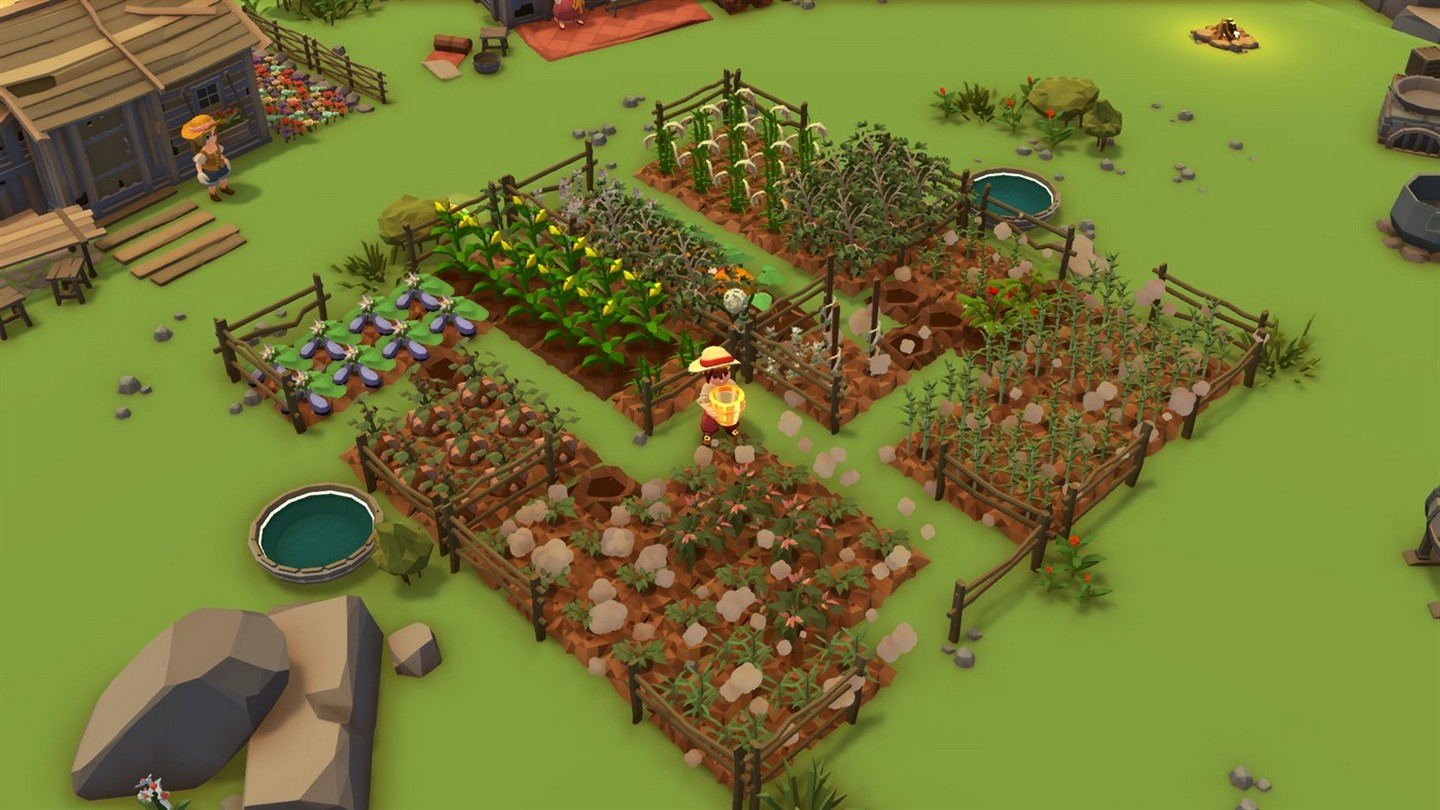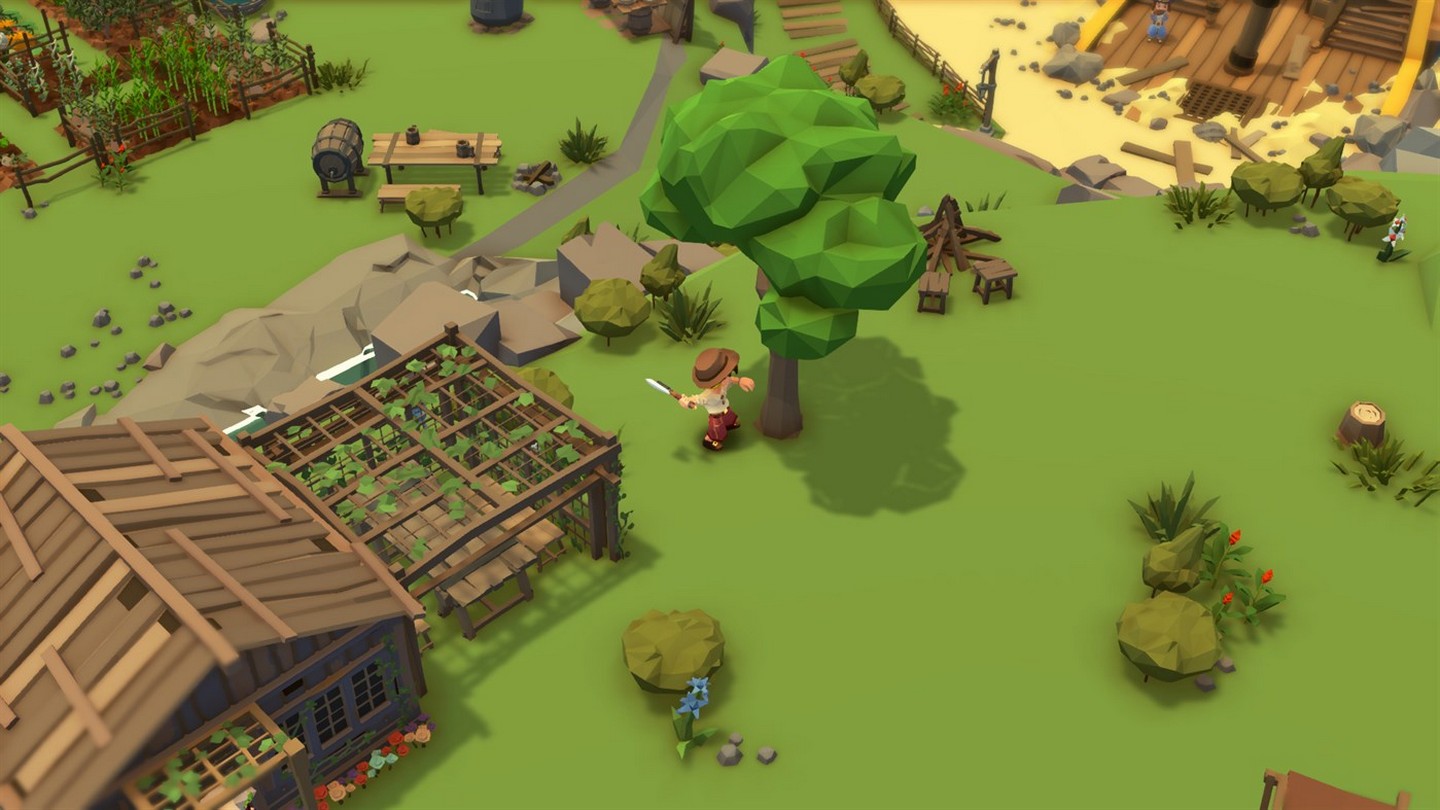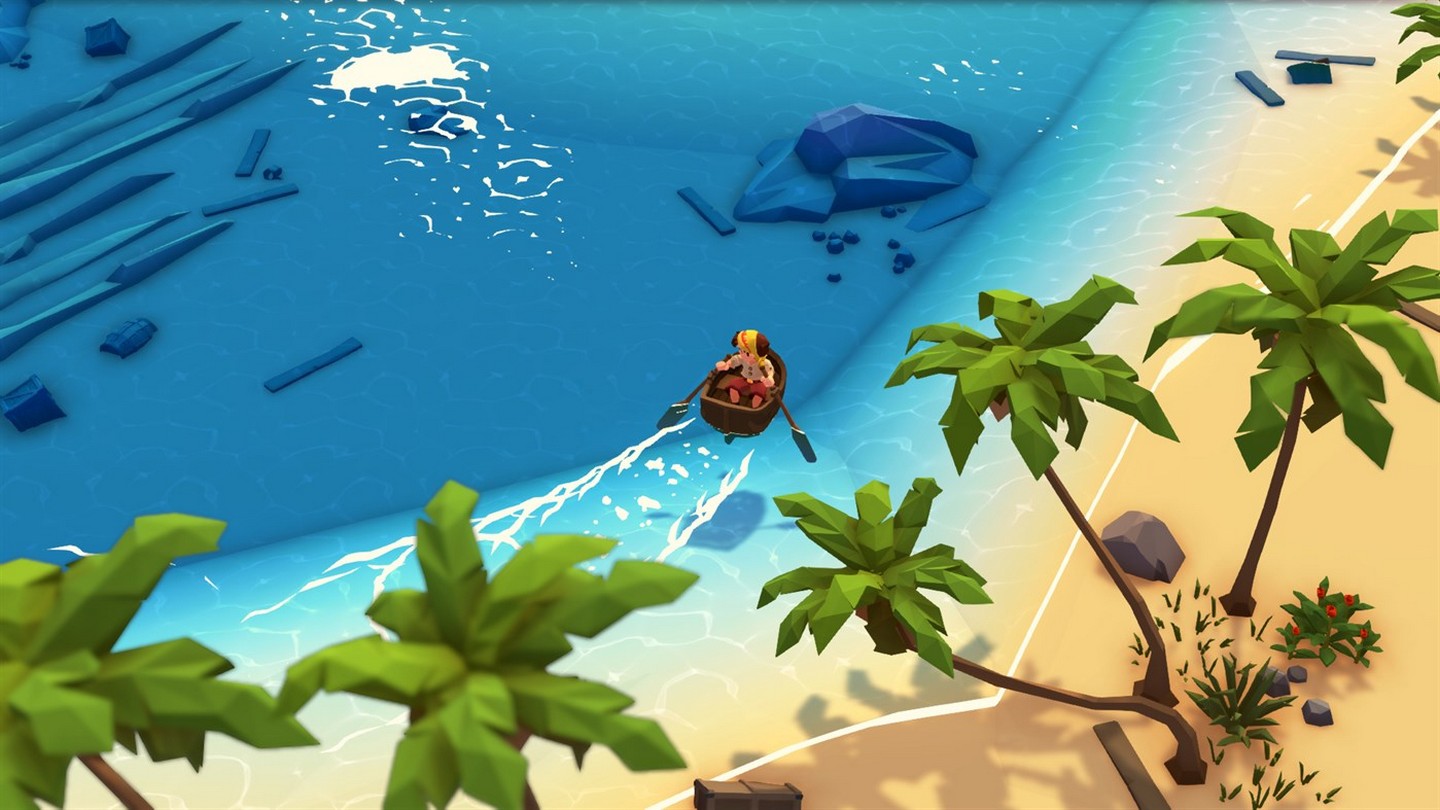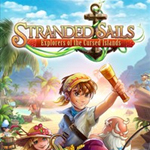Jack of all trades, master of none
Genre defining games are rare. A couple of times a generation a game will come along that either turns an established genre on its head, redefines a classic loop, or creates a new type of gameplay out of whole cloth. Much more common are games that take what others have revolutionized and iterate, improve, and reestablish the individual pieces in a new skin. Stranded Sails: Explorers of the Cursed Islands is a game that clearly had many influences. The developers have attempted to blend aspects of Stardew Valley, Harvest Moon, Zelda, Minecraft, and every Metroidvania game you’ve ever played into an energy meter driven exploration and survival game. Unfortunately, they made the decision to include 5 or 6 half-baked influences instead of 2 or 3 fully realized ones and have created a game that, while interesting at a surface level, quickly becomes a tedious exercise in fetch quests.
To start with the positives, visually the game is very sharp. Stranded Sails features a great use of color and lighting, particularly at dawn and dusk, and the blocky characters and environments compliment the game’s overall feel very well. Menus are functional, if a bit overcomplicated. I’m not a fan of the right stick controlling tool/food/seed selection, as I had several times where my hand accidentally brushed the stick and caused me to equip a different tool (especially troublesome when you’re carrying a bucket of water and changing to a different tool empties your bucket). The music in the game matches the visuals perfectly and really creates a pretty solid overall aesthetic.

MSRP: $24.99
Platforms: Switch (reviewed), XB1, PS4, PC
The gameplay consists of six major components that combine to create the general “loop” players will be playing through for the games run time, Farming, Cooking, Exploration, Crafting, Fishing and Combat. The farming in the game is a very simplified version of mechanics established in games like Stardew Valley or Harvest Moon. Players collect seeds, plant them, water them, and wait for them to grow. They start out with a small plot of land to farm on and can upgrade it as the game rolls on through the camp upgrade system (more on this later). In general though, I found upgrading it low on the importance scale. Farmed food grows very fast and I almost always had more of the food I could grow on the farm than I needed. In fact near the middle of the game I started accumulating seeds for several of the early types of vegetables simply because there was no reason for me to continue planting them. You see some plants (corn as an example) continue to produce food forever without replanting a new seed. Plants that do require players to dig them up and replant them will always give a seed when you dig them up. Because of that, midway through the game I had more than 30 unused corn seeds that just sat in my inventory because I had no use for them. Some of the more rare seeds (Pumpkins, Eggplant, etc.) gave me a risk of running low, but the standard stuff was always so plentiful I had more than I could ever do anything with. Since the game has no monetary economy any excess would be wasted. I learned quickly to replace those crops with new, rarer crops, which limited the utility of additional farming land.
The purpose of growing food is to cook with it. The cooking system in the game is actually probably its most well fleshed out system, if a bit broken in some areas, and consists of two major parts, individual recipes that players can carry with them and the large pot of stew that they make for their mates at camp.
Let’s start with the food players can carry with them. Different foods provide varying levels of energy for the player, which every other system and indeed the entire overarching loop of the game requires, and rarer ingredients produce more potent recipes. Food has to be cooked in order to be consumed, so I couldn’t just eat all that surplus corn by itself. In order to cook each of the delicacies on the menu, I had to first figure out the recipe. Unfortunately, players can’t just combine foods together and come across “happy accidents”. The game has a puzzle like system to unlocking new creations and it is unfortunately more busted and frustrating than fun.
The first recipe the game teaches is a single ingredient one, take a cob of corn and turn it into a roasted ear of corn. Every recipe after that has between 2 and 4 ingredients that players will discover throughout their time with the game. Each new island contains new food items, spices, and fish to catch. Once players have collected new parts to a recipe, a question mark will appear in their recipe list and they can attempt to piece the dish together. This requires players to take potential ingredients, with no hint as to what they might be other than “you haven’t had this combination in your inventory before” and to place them in the right order in a series of bubbles in the middle of the screen. Once I had placed all the ingredients the game would tell me how many ingredients were right and in the right place, how many were right but in the wrong order, and how many were just flat wrong.
The challenge with this system is there is no clear visual indicator as to which one is right or wrong and no easy way to tell what ingredients should stay or go. Each recipe then becomes an episode in trial and error as players move ingredients around between the bubbles and their inventory until they find the right combination. If during this process they could accidentally discover a new recipe this set-up might not be as tedious as it is, but they aren’t given that option. Players have to select the right combination only for the recipe they have selected. It’s an unnecessarily complicated and tedious system that makes discovering new recipes a chore rather than something enjoyable. Also, as players get further in the game and find new foods they will sometimes unlock recipes further down the list on the energy scale, which are worthless to unlock unless they just gotta catch ‘em all.

The second piece of the cooking puzzle in the game is the camp stew. This basically consists of throwing an ingredient in the pot for each of the members of the crew that the player has unlocked so far. Each of the crew members has a favorite food, and throwing that in the pot for them (by putting it in the bubble next to their face) will increase a pink meter which reflects the contentment of the team with the stew. Once the pink bar makes it all the way around the level number in the center will increase, and players will unlock a new upgrade either for the camp or tool-set. I really liked this method of leveling up the camp/tools and felt like it added a certain degree of camaraderie to the proceedings that felt forced in other circumstances. Just don’t forget to chase down the crew member who has the upgrade before leveling up the stew another time, or players won’t get credit for the level up and will have to wait a full cycle to get their next upgrade.
All of this cooking and energy storage fuels the primary purpose of the game, exploration. Most will spend their time in the game going back and forth between a series of islands to find crew members, artifacts, supplies, crafting materials, and other items. As should be no surprise at this point the game is built to limit exploration by requiring energy to do everything from walk to run to row a boat across the ocean to another island. In this area, the game really starts to show its tendency to bore the player in the interest of sucking energy.
Movement in the game is a slog at normal running speed, and using the option to sprint drains energy incredibly quickly. Players are limited pretty substantially in the amount of food items they can carry (especially early in the game) which means a LOT of out and back fetch quests and burning precious energy traipsing around a camp that seems to be poorly designed to purposely take as much energy as possible to get around really got old quick. The primary gameplay loop of the game is get a quest to go out to find something (crafting materials, crew member, etc.), teleport back, talk to someone across camp, go back to that same island again to find something else, teleport back, cross the camp again, etc. The entire game consists of this loop and I was tired of it very quickly. While the game is “open world” players are very clearly conditioned to stay on the game’s prescribed path due to energy consumption and areas that are inaccessible without later game equipment. This means players are essentially playing fetch quests over and over again. The size and energy-draining design of their own camp means even a quest like “go talk to this person across camp” will drain enough energy that they will want to stop halfway through to have a bite of stew and fill up on energy in case they are sent across the ocean by the person they’re talking to. I can’t express enough how boring the game quickly becomes and how uninteresting many of the tasks are.
Complicating matters is the tacked on and incredibly underwhelming crafting system. This system requires various materials that one can collect throughout their journey (wood from trees they’ve cut down, material from crates, etc.). While each area that they visit has a nice supply of crates with some materials in them, they don’t refill until heading back to camp and they can generally only collect the material for one or two crafted items for each visit. That plays out in some really tedious back and forths to islands collecting materials, crafting them at thecamp site (the only place players can craft them) and then heading back to the island to use whatever they crafted. Many of the camp upgrades need crafted and multiple major story items need crafted as well, and there are only a small amount of components. This makes the crafting system feel like a real chore that requires more back and forth navigation (something I’ve already mentioned the tedium of) than it’s worth.
A great example of this is close to the mid-point of the game when players have to collect materials to build portable bridge kits to access new areas of the island. This requires having sufficient materials to build the kits themselves. Generally, despite collecting all the materials I saw throughout the game I only ever had enough materials to create one bridge kit at a time. This meant a lot of looping back and forth to the primary island to build before moving on, artificially extending the run time of game and slowing the pace to a crawl.
The last two major systems are fishing and combat. Fishing is done via a fun, albeit simple system that requires players to time button presses to the closing of a series of ripples on the water. I actually enjoyed the simple fishing mechanic but also found myself hesitant to do it for too long because of the resultant energy drain (especially before a mid-game upgrade to the fishing pole). I did enjoy seeing which new fish or sea creatures I would be able to catch as I visited each new island.

Combat is the definition of tacked on and shallow. When I learned that my crew had a tailor and blacksmith on board I hoped for some type of armor or weapon system but, alas, that isn’t really present here. There is no combat at all until nearly two-thirds of the way through the game (estimated) and what is there is basically just swing the sword and run away. There are no advanced moves, dodges, counters or defensive moves here. That makes the addition later of of a combat “arena” style area feel completely useless as the combat isn’t entertaining enough to spend time doing only that.
In summation, Stranded Sails feels like a lot of potentially interesting combinations of systems and ideas that, in execution, is just too shallow and tedious to be all that much fun. The game certainly feels like it knew it didn’t have enough substance to stretch for their desired run time and thus slowed down and over-repeated the same loops to last longer. That’s really the only excuse I can think of as to some of the decisions made here. The shame of it is with some additional polish and deeper ideas the concept of a farming/exploration/action RPG can work very well, as we’ve seen with several other recent games. In this case though I can’t really recommend the game to anyone other than potentially younger players looking for a first entry into this style of game or huge fans of the farming/exploration genre who are desperate for something else to play.
Review copy of game provided by publisher.
